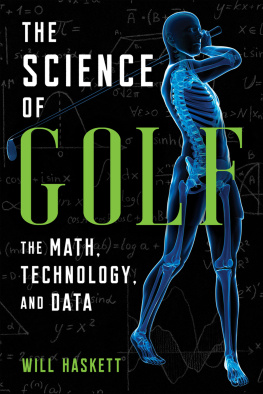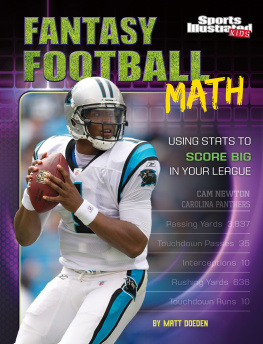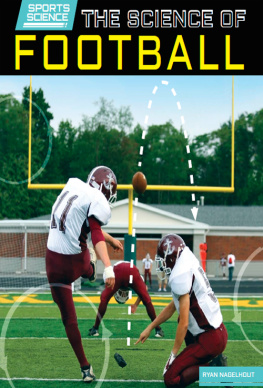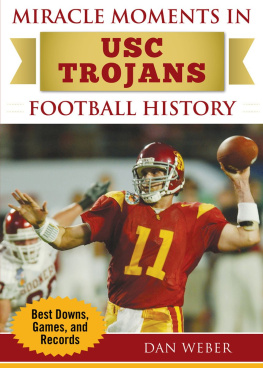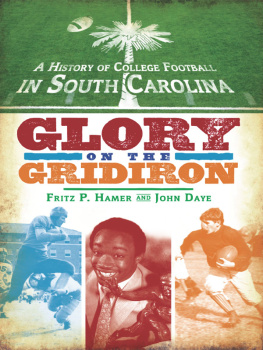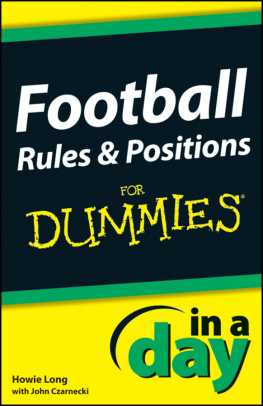
To my dad, Chris Brooke, for always being my biggest supporter.
Tyler Brooke

Copyright 2022 by Tyler Brooke and Will Carroll
Foreword 2022 by Peter King
All rights reserved. No part of this book may be reproduced in any manner without the express written consent of the publisher, except in the case of brief excerpts in critical reviews or articles. All inquiries should be addressed to Sports Publishing, 307 West 36th Street, 11th Floor, New York, NY 10018.
Sports Publishing books may be purchased in bulk at special discounts for sales promotion, corporate gifts, fund-raising, or educational purposes. Special editions can also be created to specifications. For details, contact the Special Sales Department, Sports Publishing, 307 West 36th Street, 11th Floor, New York, NY 10018 or .
Sports Publishing is a registered trademark of Skyhorse Publishing, Inc., a Delaware corporation.
Visit our website at www.sportspubbooks.com.
10 9 8 7 6 5 4 3 2 1
Library of Congress Cataloging-in-Publication Data is available on file.
Cover design by David Ter-Avanesyan
Cover photo credit: Getty Images
ISBN: 978-1-68358-459-9
Ebook ISBN: 978-1-68358-460-5
Printed in the United States of America
CONTENTS
FOREWORD
Not long ago, I was talking to a top NFL decision-maker, someone with the most power in his organization aside from the owner, about analytics. This person told me what his team was looking for in new football-intelligence employees.
Someone smarter than we are, and someone who thinks different than we do, this decision-maker said.
So this person went to a brainy East Coast university to talk to grad students in several programs about football analytics, and to see if any of them would fit his organization. He explained how there was lots of datafrom GPS tracking of players, to deeper statistical analysis of player performance, to managing player health by measuring high-stress markers during practice and gameshis team wasnt sure it was using well.
He interviewed ten or twelve people, and asked three back for second interviews. Two were men, and they showed up in crisp business attire. The other was a woman. She didnt know much about football, wasnt a fan, barely had heard of this team. But in the second hour of the in-person interview, she suggested something (I dont know precisely what; analytics is a classified operation inside most NFL buildings) about the GPS data and performance that lit a light bulb above this decision-makers head.
This team hired two of the interviewees, including the woman. I hear shes brought new ideas to the organization. When I hear the buzzword analytics about the NFL these days, I think of that.
But its not just math/science brains changing the landscape in the NFL. Its people thinking differently. Its Nick Saban, at Alabama, hiring fired coaches for a season or two, while theyre between jobs, to educate his staff and players about things like RPOs (run-pass option plays). Its then Eagles coach Doug Pederson empowering the coaches on his staff to think of better ways to run playsand thinking of better plays, period. And listening to the coaches, with a no-good-idea-gets-left-behind mantra... the kind of philosophy that led to the winning play in Super Bowl LII.
Football is a smarter game than its ever been. And I am going to tell you a story about one of the reasons it is.
Early in this century, a football nerd named Neil Hornsby lived in Luton, England, and he had a dream: What if I could organize a different way to look at football than is currently done? What if I could grade every player on every play of every gamewith the kind of quality analysis that NFL executives and coaches would respect? He started this deep analytical look at games, but couldnt gain much traction in the NFL, in part because it took a long time to look at every play in a game twenty-two times, minimum, to judge how each player on the field did on the play. Plus, most NFL people didnt trust that Hornsby and his band of merry football freaks from all over the globe really knew the game well enough to know the assignments of every player. (Truth is, they dont. So Pro Football Focus was never meant to be flawless.)
By 2009, Hornsby was on the verge of giving it up. He couldnt find enough fans and teams to pay the bills. But he stuck with it another year, and one team, then two, then four started paying for snap counts and formation numbers and things like that. Hornsby was emboldened, and even whenas happened in 2011 when he toured some NFL training camps to try to drum up businessone GM thought some bloke with a thick accent could never know this distinctly American game and told him he had no interest in his numbers, Horsnby persisted.
In 2014, Cris Collinsworth, a huge PFF fan who used its stats and numbers in his weekly preparation for Sunday Night Football , bought a majority stake in the company. And in 2017, it was all worth it.
In Super Bowl LII, with the Patriots up 3332 on the Eagles with 2:25 left, Philly had a third-and-7 at the New England 12-yard line. Nick Foles leaned into the huddle and called:
Gun trey left, open buster star motion... 383 X follow Y slant.
The Eagles had flown to Minneapolis the previous Monday with 192 plays on Doug Pedersons Super Bowl play sheet. Hed told his staff the hay was not in the barn, and if you guys find a better play, Ill sub it in for one of the existing plays. Late on Monday night, in his Radisson Blu hotel room by the Mall of America, receivers coach Mike Groh found something. Groh was the offensive assistant assigned to study all stacks and bunches from every other game in the league. Groh noticed the Patriots having some trouble with Jet Motionthe sprint motion by a back or receiver pre-snapand noticed they had trouble with stack formations too.
Groh used the database of Pro Football Focus to find every play that year the Patriots faced that sprint motion, and how they responded to four receivers overloading one side of the field. Groh wondered, What if we did both on the same play ? He brought the idea and PFF evidence to offensive coordinator Frank Reich, who took it further up the food chain to Pederson. The head coach loved it. He put Gun trey left, open buster star motion... 383 X follow Y slant in the game plan. Grohs idea. Pederson loved how it would put tight end Zach Ertz alonethe Eagles thoughton Pats safety Devin McCourty with no help available.
The Eagles practiced it twicethats itduring the days leading to the game. And with the season on the line in the Super Bowl, Pederson called it.
The sprint motion (Star Motion, in the Eagles vernacular) worked perfectly and left Ertz on McCourty, one on one. No help. Foles hit Ertz. Touchdown. Eagles win.
What I love about that? The confluence of an invention by a Briton (Hornsby) who loved football, data, hard work, imagination, trust in a position coach and guts to call a newly invented play on the biggest stage of the year won a Super Bowl.
It wont be the last time data and new thoughts win a Super Bowl. Thats one of the things that makes pro football so interesting right now, early in its second century.
Peter King, 2022
INTRODUCTION
Smashmouth. Slobberknocker. Hog Mollies. Big Uglies. Theres a ton of fun football terms that sound like exactly what they are. To the uninitiated, NFL-style American footballwhich we will henceforth just call football for ease, with apologies to the world game well call soccer hereis anything but scientific. Its big men smashing into other big men. George Plimpton once called football violence punctuated by committee meetings. He wasnt wrong, but the game has evolved from a more violent and frankly more American game, into something that looks more like America in 2022. Theres more technology, more complexity, and much, much more science in the game.
Next page



